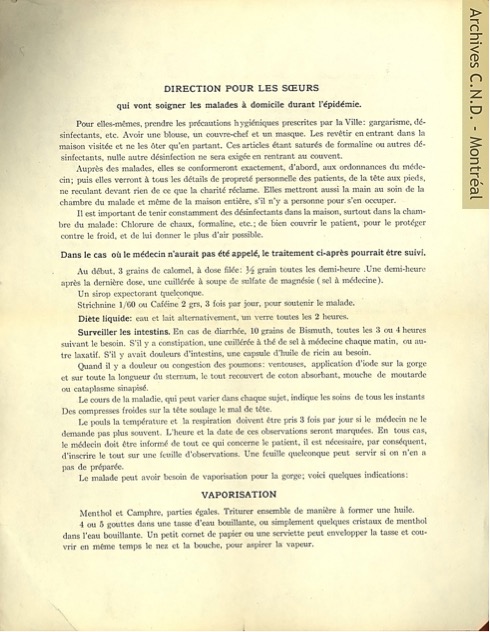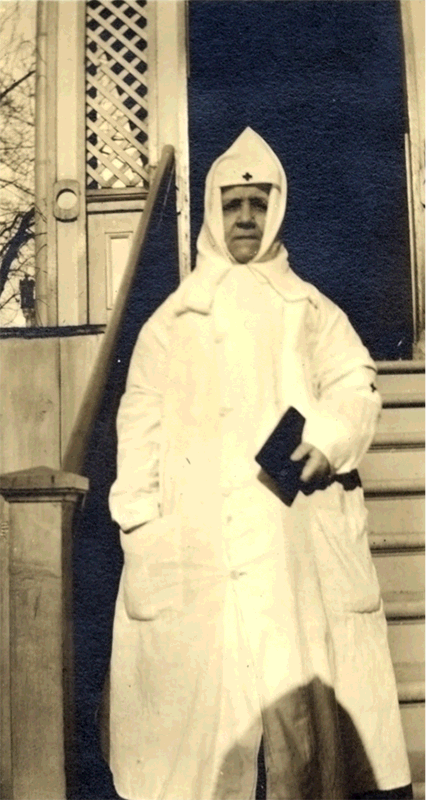Spanish Influenza: Excerpt from Histoire de la Congrégation de Notre-Dame
Photo: Sister Saint-Alfred (Délia Clément) during the Spanish Flu epidemic, [Montreal, Quebec], [1918?]. Archives Congrégation de Notre-Dame – Montreal (200.100.018)
Spanish Influenza: Excerpt from Histoire de la Congrégation de Notre-Dame, Volume XI, book 1: 1900-1950, 1972, p. 35-37.
In 1918, throughout the world, and particularly in Canada, an influenza epidemic known as the Spanish Flu, brought grief to thousands of families and decimated the population. Because hospitals, doctors and nurses could not help all the afflicted, the Archbishop of Montreal asked the religious communities to organize free volunteer services for the poor and all who could not get help. A Circular letter from the Superior General called on the sisters in Montreal:
From our Mother House, this October 16, 1918.
My dear Sisters,
The epidemic that is sweeping throughout our Province is taking on alarming proportions in our city. Hospitals can no longer cope with the ever-increasing number of sick people who are dying for lack of care and help.
This morning, in an effort to bring help at a time of such great suffering, the Archbishop of Montreal has called on religious communities to bring their charitable assistance to the hospitals that the city has opened temporarily.
To this invitation of our worthy and venerable Prelate, we can only respond with all our generosity.
For this purpose, my dear Sisters, upon receiving this letter, which the Superior will immediately read to you, you will gather in your chapel and recite the Veni Creator and the Ave Maris Stella. Before God, you will prayerfully reflect on the merit and excellence of the sacrifice being asked of you. If in the depths of your soul, Our Lord appeals to your generosity, you will immediately send me your name. Your decision will be guided by the one and only inspiration of Jesus in the Tabernacle.
Our venerable Mother Bourgeoys who cared for soldiers suffering from typhus on the ship that brought her to our fledgling colony and who dedicated herself in Ville Marie to burying the dead and to all charitable works will be your model. I do not doubt that this new way of imitating her will reward you and all her dear religious family with unique blessings from heaven.
I have the firm confidence that the Blessed Virgin will always give you the strength and courage you will need to face the difficult current situation.
I commend myself to all of you, my dear Sisters,
affectionately devoted to Mary,
Sister Sainte-Euphrosyne, Superior General, C.N.D.
Many Mother House sisters offered to work in temporary hospitals, namely the Meurling Shelter. The organization was under the executive direction of Sister Sainte-Marie-Ananie, General Custodian; a Grey Nun or a Sister of Providence accompanied each of the CND sisters. The sisters devoted themselves to about one hundred patients in the Meurling emergency hospital, on Saint-Louis Street. With love and faith, they provided the most humble and repulsive services in the most precarious conditions. The Messieurs de Saint-Sulpice were responsible for providing spiritual assistance. Monsieur H. Legrand, P.P.S., the parish priest of Bon-Secours, dedicated himself tirelessly with Messieurs René Labelle and Waddell. The sisters had the consolation of helping many souls find God again before crossing the threshold of eternity: a new austere yet comforting apostolate, that will reveal its secrets beyond this life.
On October 20, 1918, faced with a shortage of Protestant nurses at the Alexandra Hospital, the superintendent of the Victoria Hospital in Montreal requested the sisters’ help. Provincial Superior Mother Sainte-Cornélie, answered the call with Sister Saint-Gabriel, Sister Saint-Hubert and Sister Saint-Vincent-de-Sienne. They were welcomed with some surprise and much gratitude. Finally, on November 6, the epidemic seemed to have been overcome. The Congregation wrote meaningful pages of history at the service of the Church. In our time, these pages would speak of ecumenism, social and pastoral collaboration. The sisters acquired new knowledge about human beings and the desire to form more and more students for service and charitable works.

Commemorative metal plaque given to the sisters of Saint Patrick Academy for their devotion and sacrifice during the October 1918 epidemic, Montreal, Quebec, [1918?]. Archives Congrégation de Notre-Dame – Montreal (315.370.070)

Instructions for the sisters who provided home care to the sick during the Spanish Flu epidemic, Montreal,
Quebec, [1918?]. Archives Congrégation de Notre-Dame – Montreal (200.100.018)
INSTRUCTIONS FOR THE SISTERS
who provide home care to the sick during the epidemic.
For themselves, they will take hygienic precautions, as set by the city: gargling, disinfectant, etc. They will wear a gown, cap and mask. They will put them on when entering the home and only remove them when leaving. Since these items are already saturated with formalin or other disinfectants, there is no need to further disinfect on returning to the convent.
For the patients, they will, first and foremost, comply fully with the doctor’s orders. Then they will see to all the details of the patient’s personal hygiene, from head to toe, not backing away from anything that charity demands. They will also aid in tending the patient’s room and even the whole house if there is no one to do it.
It is important to always keep disinfectants in the house, especially in the patient’s room: lime chloride, formalin etc., to cover the patients well to protect them from the cold and to give them as much air as possible.
When the doctor has not been called, the following treatment can be followed.
At the beginning, 3 grains of calomel in small doses throughout the day: ½ grain every half hour. Half an hour after the last dose, a spoonful of magnesium sulphate (Epsom salt).
Any kind of expectorant syrup.
Strychnine 1/60 or Caffeine 2 grains 3 times a day to sustain the patient.
Liquid diet: Alternately 1 glass of water or milk every 2 hours.
Monitor the intestines. If there is diarrhoea, 10 grains of Bismuth every 3 or 4 hours as needed. If there is constipation, 1 teaspoon of Epsom salt every morning or any other laxative. If there is intestinal pain, one capsule of castor oil as needed.
When there is pain or congestion in the lungs: suction cups, application of iodine to the throat and the entire length of the sternum, cover with absorbent cotton, mustard dressing or cataplasm.
The course of the disease, which varies from patient to patient, indicates the type of sustained care to provide. Cold compresses on the head relieve headaches.
Blood pressure, body temperature and sounds of breathing need to be taken 3 times a day or more if the doctor requests it. The date and time of these observations are to be noted. In any event, the doctor must be informed of everything that concerns the patients. It is, therefore, necessary to write everything on an observation chart. If none has been prepared, any sheet will do.
The patient may need inhalation. Below are some guidelines:
INHALATION
Menthol and camphor in equal parts. Crush together to form an oil. Put 4 or 5 drops of this oil or just some menthol crystals in a cup of boiling water. A small cone of paper or a towel can wrap the cup and at the same time cover the nose and mouth to inhale the steam.
